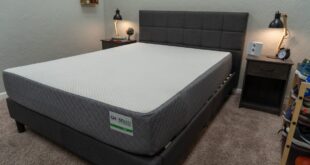Some of the items listed are user-friendly for both experienced and new exercisers. I recommend connecting with a personal trainer or someone who knows their way around the gym to show you how to use some of the equipment you’re unfamiliar with.
Suspension trainer: The suspension trainer is a great tool to use as a beginner or if you’re experienced, you can use it to make other bodyweight exercises harder or easier. It has adjustable straps and would require hanging an anchor over a doorframe or having a sturdy and tall horizontal bar (like a pull-up bar) to clip it to. The straps can be adjusted to suit the type of exercise you’re doing. Luke Zocchi, a Centr personal trainer says the great thing about suspension trainers is that they engage multiple muscle groups simultaneously while also improving core stability. He explains, “the suspension trainer is great for all skill levels you can use it to increase the difficulty of an exercise or it can be used to decrease the difficulty of an exercise.” Therefore, for beginners, this is a good tool to use if you need extra support doing squats, lunges and inverted rows. For experienced users, you can challenge your upper body with push-ups, tricep presses, bicep curls, inversions and even add in a kettlebell or dumbbell.
This is the suspension trainer I have at home that I normally hang behind a door to use.
Yoga mat: A yoga mat takes up minimal space and can be used for bodyweight or weight-bearing exercises as well as stretching, Pilates and yoga. You can also transport it easily if you want to take it with you when you travel. Zocchi recommends looking at the thickness, material, texture and size of a yoga mat. “Thickness will determine how comfortable and supportive a mat will be on your body, while material and texture will help ensure you have a mat that prevents slipping on all surfaces, especially after a sweaty workout,” he explains. Additionally, he points out that standard mats are typically 68-72 inches long, so depending on how tall you are, you can choose a yoga mat that is most comfortable for your height.
A yoga mat can be used for various activities and it doesn’t take up a lot of space.
Jump rope: The same applies to a jump rope which is compact enough to throw in your gym bag to take to the park or use indoors. It’s an easy way to do cardio and create circuits with your own body weight or with strength training exercises. Zocchi recommends when buying a jump rope that you look at these factors: the handles, length and weight. “The handles should have a comfortable grip to prevent hand fatigue, while the length of the rope should be able to accommodate your height,” he explains. Also keep in mind that the heavier a jump rope is, the more resistance it will provide for a challenging workout.
A jump rope is portable and easy to use both indoors and outdoors.
Kettlebells: If you’re new to kettlebells, this piece of equipment is a good alternative to dumbbells and can also be used to do squats, deadlifts, overhead presses and core exercises. The kettlebell is designed like a cast iron cannonball with a handle in the middle, so when you hold it, the weight is evenly distributed in your hand, whereas with dumbbells the weight is on each end. Zocchi says, “it’s important to purchase a kettlebell that has a good grip as a smooth and slippery handle can make it difficult to maintain a secure grip.” They’re a good strength training tool, but if you want to take things up a notch, you can use them for cardio and learn from a certified kettlebell trainer how to do kettlebell swings, cleans, snatches and so much more to get in a full body workout.
Kettlebells can be used for strength and cardio training.
Dumbbells: If you’re set on dumbbells it’s a good idea to have multiple pairs. Zocchi says, “the weight sizes you should own depend on your fitness level, but we generally recommend that you have light, medium and heavy weights so you can challenge yourself at all levels.” You can even opt for an adjustable dumbbell if you prefer since these tend to offer a various range of weights (usually 5-50 pounds) while also saving space. Having these options allows you to easily regress and progress exercises as needed.
A dumbbell rack keeps your weights store away neatly and easy accessible.
Resistance bands: I took into account that perhaps not everyone has the space to have dumbbells or kettlebells and the alternative can be resistance bands. Resistance bands come in a variety of weights and lengths. Zocchi says when shopping for a resistance band, it’s important to look out for three things: resistance level, material and length/width. “Lighter resistance bands are great for beginners or exercises focusing on mobility and rehabilitation, while heavier bands provide more resistance for strength training,” he explains. Resistance bands are commonly made from rubber, latex or fabric. Zocchi says, “Rubber resistance bands tend to break easily during workouts, so the best option for minimal wear and tear is a fabric option.” I personally keep both long and mini resistance bands because it’s an easy way to make most exercises harder or for a warm-up.
Resistance bands come in long and short styles and have different weights.
Adjustable weight bench: If you have the room, an adjustable weight bench is complementary to dumbbells, and you can use it to do exercises like lying chest presses, bent-over dumbbell rows, tricep dips and other upper body exercises on an incline or flat. Most adjustable ones allow you to fold them flat or into a more compact size for easy storage. When shopping for an adjustable weight bench, Zocchi says it’s important to keep stability, adjustability and padding and comfort in mind.
Medicine ball: A medicine ball is a leather-bound weighted ball that comes in a variety of weights, so choosing the right one will depend on what you’re using it for. Usually, medicine balls are used to build power, so you want something that’s manageable for you to maneuver with speed but still challenging enough. These types of explosive movements include exercises like wall balls, ball slams and med ball chops.
You can practice some serious power moves with a medicine ball.
Cardio equipment: Finally, some people just want a piece of equipment that they can hop on and move. That’s where owning a piece of cardio equipment can be helpful. Choose one based on your space capacity and which you’re most likely to use. If you get bored going at one pace on an indoor bike, treadmill, rower or elliptical, you can always come up with circuits to do in less than 30 minutes. These might include sprinting on the machine followed by a rest period and a few bodyweight or weight-bearing exercises, repeated multiple times.
The Peloton Tread is the ideal treadmill to splurge on if you love doing interval training.
 meganwoolsey Home
meganwoolsey Home



